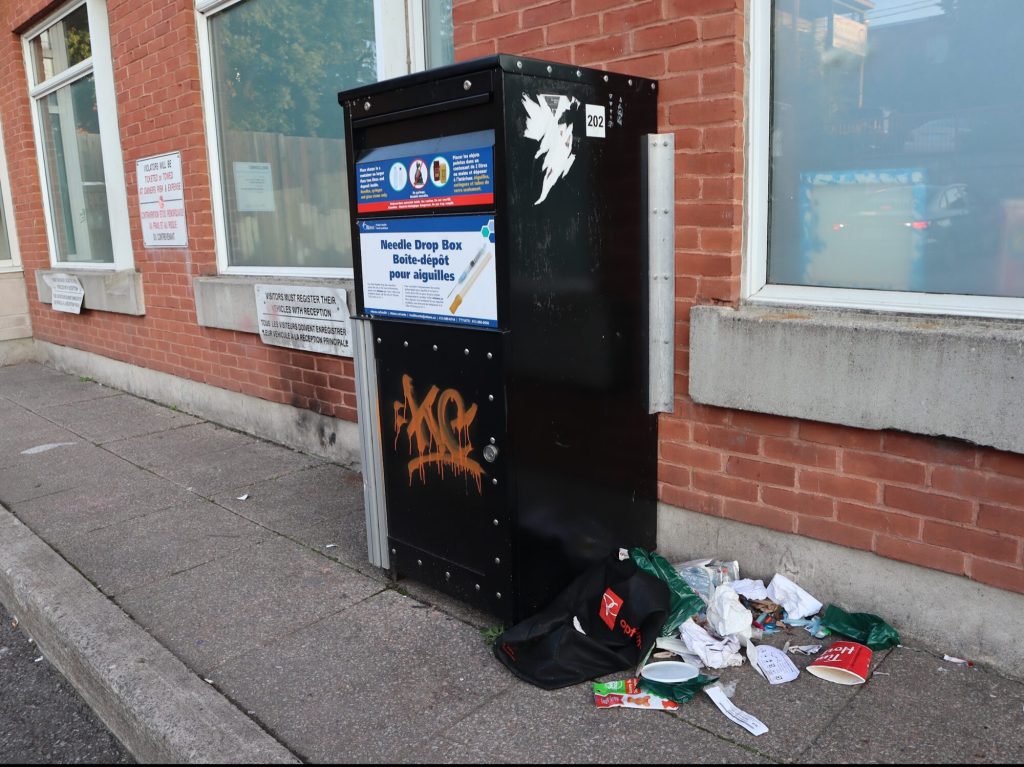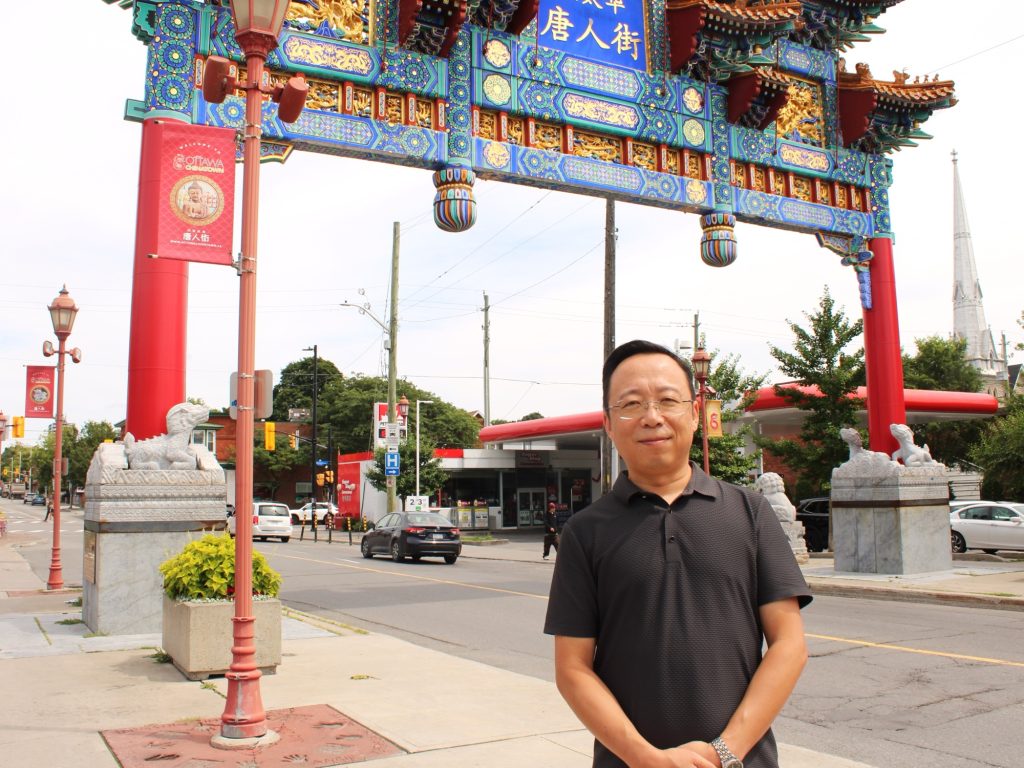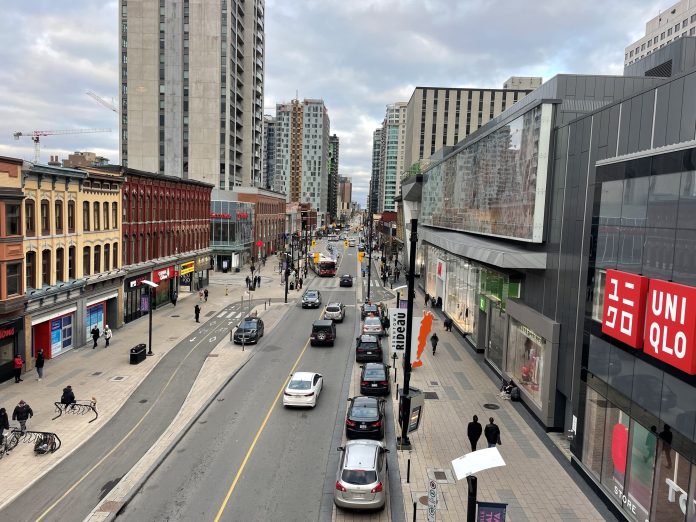It’s a Thursday evening in late August, and paramedics are responding to an overdose call on Somerset Street near Booth Street.
Down the street, used doses of naloxone are scattered on the sidewalk near a safe injection site. These have become regular sights in Centretown.
Ottawa is in the middle of an opioid and drug epidemic. Recent statistics are hard to come by, but Ottawa Public Health reported in 2017 that an estimated three per cent of the city’s population used illicit drugs besides cannabis within the year.
For high school students, about one in 10 students reported using illegal drugs such as cocaine, hallucinogens or ecstasy.
While issues in Centretown are not new, residents and business owners say the problems are getting more grim. Somerset Ward Counc. Ariel Troster met with Ottawa Mayor Mark Sutcliffe in late July to discuss the homelessness and drug crisis that she says is getting worse after an increased police presence in the ByWard Market.
“It’s been something we’ve all been noticing,” said Troster in the 90-second video. “There have been more people gathering, using drugs in public and there have been some fights and some aggression happening among people who often don’t have another place to go.”

“Some councillors, like Rideau-Vanier representative Stephanie Plante, have questioned Troster comments, arguing that Somerset Ward has a higher presence of law enforcement than other jurisdictions. She also said the increased police presence was not in place when the Somerset councillors remarks were made.
“I don’t really understand it, because Ariel has the headquarters of the Ottawa Police Services on Elgin Street. By that logic, people would be pushed into other areas whether it be the Glebe, Little Italy or Hintonburg,” said Plante. “Ariel has a higher presence of law enforcement than I do.
“She has the Parliamentary Protective Service, which has jurisdiction from Elgin Street to Wellington Street from Bay Street to Colonel By Avenue. She has Canadian Armed Forces on Queen Elizabeth Avenue. She has Ontario Provincial Police which guard the courthouse on Elgin Street,” Plante continued. “She has a much higher presence of law enforcement than any other jurisdiction in North America. Her comments aren’t reflective of the realities of who is circulating in her area.”
In an interview with the Ottawa Business Journal, Troster said the complex issue has been exacerbated in recent weeks.
“Centretown already has its own troubled population … So, to be clear, we were in a crisis situation to begin with,” said Troster. “But I and our service providers and business owners have certainly noticed that, since mid-July, after the new police station was opened in the Rideau Centre, that we’ve seen a migration of an additional troubled population into Centretown.
“These are folks that we maybe never have seen before. We’re seeing groups of five, six, seven, eight people sitting on the sidewalk injecting or smoking drugs publicly. There have been some fights,” Troster explained. “One individual told a (local business owner) directly that he’s gotten out of the Market because the police presence has essentially forced him out of there.”
Police hope increased presence will deter crime
Sgt. Paul Stam, Ottawa Police’s neighbourhood policing director, said it would be premature to suggest issues are moving from the market to other parts of the city.
Stam, who is also the operational lead for the community outreach response and engagement core strategy, said “hotspot policing” — which aims to deter crime in communities that have reported increased issues — have been tested in over 100 countries around the world. He said the model will be evaluated every few months to ensure they are reaching full benefit.
“The research on these police interventions, hotspot policing, shows that overall displacement is generally not an issue,” Stam told KT. “More than likely, you will see a diffusion effect where having that increased presence and dealing with the problems where they are more concentrated will have a crime diffusion effect in neighbouring areas as well.”

Before working in his current role, Stam worked on OPS’ tactical team, which dealt closely with the guns and gangs and drugs units. He said police are putting a great emphasis on targeting drug trafficking on the higher, medium and street levels, but noted the supply is “limitless.”
New drugs are also hitting the market, lacing the current supply, and are oftentimes unbeknownst to the user.
In April 2022, William Bernard, a 21-year-old student from Barrhaven, was Ottawa’s first overdose death to Flubromazolam. The drug also known as “liquid Xanax” is a triazolobenzodiazepine, which are benzodiazepine derivatives. The Algonquin College student thought he was taking regular Xanax after trying to cope with generalized anxiety disorder.
This past June, Ottawa Public Health announced “N-pyrrolidino etonitazene” —also known as “pyro” — was detected for the first time. The nitazene opioid is 10 times more potent than fentanyl and between 1,000 and 1,500 times more potent than morphine. It was hidden in counterfeit hydromorphone (Dilaudid) M8 tablets.
“The harm reduction infrastructure that we have in place is not enough to keep up with how quickly it’s evolving,” said Stam. “You’re constantly having new elements enter the drug supply, whether it be tranquilizers or benzodiazepines, and all of that complicates the response, because narcan doesn’t work on those drugs.”
“It changes how people act, changes the dependency, and changes the addiction potential.”
This is part of the reason why more unlawful and sporadic behaviour from drug users is being encountered on Ottawa streets, Stam said.
Centretown crime on the rise, says community association
Brenda Knight, chair of the Safety Emergency Preparedness and Wellness Working Group for the Centretown Community Association, said she’s seen the issues worsening over the past 12 years.
“We’ve always had people with challenges in Dundonald Park. The other day, people were lying on all the benches at Park of the Provinces, which is new,” said Knight. “The gardener needs to go and clean out the needles before his crew can do the work.”
Open drug deals in the middle of daylight are becoming the norm in Centretown, and unhoused people are camping out anywhere they can find, she said. The community association is looking to hold a webinar to discuss how residents can keep their home safe, particularly for multi-unit dwellings.
Knight, who does believe her community’s issues are worse because of the ongoing situation in the ByWard Market, said people are sleeping in the entrance doors to condos, including her own, which is now installing lighting to deter the unwanted visitors.
“The amount of theft is unbelievable. Packages are being stolen from the mailroom. Bike (thefts) are also up. Compost bins are being stolen. People without a home are using them to put their items in to stay dry,” said Knight.
Knight was disappointed to hear that the Somerset West Community Centre would be forced to close its safe consumption site next March due to new provincial action, and said she fears it will only make the community’s existing problems worse.

But Yukang Li, executive director of the Chinatown BIA, welcomed the news, saying he felt its presence in the community was leading to an increase in crime and unlawful behaviour.
“I was talking recently to the owner of a Vietnamese grocery store. In the past week, almost everyday they had groups of up to 10 or 11 people scatter around and start stealing,” said Li. “The owner called the police, they came, and just asked them to walk away.
“One restaurant was broken into twice in three days and had iPads stolen. The owner called the police and they didn’t show up,” he continued. “Instead, they said to call a number and follow up. That phone call took two hours.”
Stam admits there are sometimes issues with police response time due to a lack of resources. Still, he encouraged residents and business owners to call police anytime they felt unsafe and said their concerns would be taken seriously.
Over at the Centretown BIA, executive director SabriNa C. Lemay said their communities’ businesses have also felt the uptick in crime.
“We’re getting a lot of people sending emails through. We’re also experiencing a lot more damage to properties … And a lot of human feces and things like that are being spread across sidewalks and in corridors and in areas that we’ve never seen before. And new people who we haven’t seen before.”
To try and change the narrative, some businesses such as Howard Fine Jewellers have employed unsheltered individuals to help clean the street. The BIA has also hired a cleaning team and businesses have been given a “who-to-call list” with resources such as helplines and crisis centre information.
One focus all parties agree on is the need to focus on the root cause of the crisis. However, councillors are adamant they don’t have enough funding to deal with healthcare and addictions, which prominently falls on the province.
Knight said she feels decisions are being made without considering long-term consequences. And while she said Ontario’s new HART addiction treatment model is being welcomed, it shouldn’t come at the cost of harm reduction measures.
“In 2022, Ottawa declared a crisis on housing, and nothing has been done. If people had homes, the social services they need, healthcare, would we be in this mess? No,” she said. “If you close one the new model needs to open right away so there is less impact on the communities. We have to recognize drug addictions and mental health as an illness.”
With files from Sarah MacFarlane and Hannah Wanamaker
